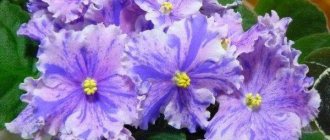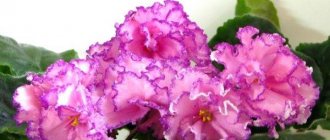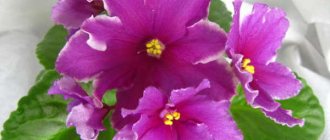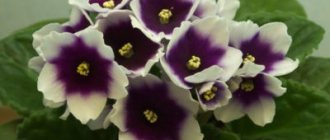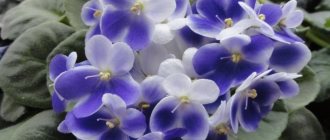Saintpaulias in their original form were deep blue. A passionate biologist in 1898, working with the plant, managed to obtain violets with petals of a red-violet tone. Then there was work on breeding different sizes of flowers, from greatly increased to decreased, in relation to the original parameters.
Breeding experiments with Saintpaulias continue today, both at the amateur and professional levels. But more often than not, this is not just a hobby or work; violet selection becomes a matter of life. Such is the charm of these colors that are both modest and vibrant.
general description
Optimara is a continuator of this idea on a large-scale level. These are no longer individual breeders working from their apartments, but a production and laboratory level of not only the active creation of many new types of Saintpaulia, but also their mass cultivation. The company's varieties are designated by the prefix of the same name to the name.
In fact, Optimara holds a monopoly on the production of varietal violets in the USA. Today, the company has branches in Asia, as well as on the African continent. Optimara annually “infuses” more than one hundred million saintpaulia into retail chains. There are no deliveries to Russia, and if Saintpaulia optimarias do end up in the homes of Russians, it is only in single copies, brought by enthusiastic violet growers, so this variety, for example, since the 80s, can be classified as new in our country. But in Holland, violet optimaras have taken root well.
Optimara violets vary in color, shape and size, but they also have characteristics that unite the varietal group:
the cutting grows quickly, up to the formation of a flowering rosette;- the plant is resistant to diseases;
- blooms early;
- flowering is very abundant and long;
- rosettes are small, usually symmetrical;
- the buds open at the same time, in large numbers on each peduncle;
- rich color of flowers;
- There is a wide range of mono colors and color combinations;
- Saintpaulia-optimaris tolerate the road well and are unpretentious;
- life expectancy is shorter than that of other varietal groups.
Among the advantages and qualitative differences of Saintpaulias from the Optimara company, one can highlight the fact that they are quite hardy and unpretentious, they bloom very generously, harmoniously and for a long time. If you manage to propagate, then the transferability of qualities will be guaranteed, since the key to the success of industrial flower production is precisely the high stability of varietal properties.
One of the disadvantages is that their varietal Saintpaulias are distinguished by their reluctance to bloom again, but if you carefully and carefully care for the plant, you can get several more blooms from it and even propagate it by cuttings. The second generation will be more colorful and will definitely delight you with bright “pansies” or “stars”.
Peculiarities
There are many advantages to growing violets at home:
- unpretentiousness in care - no special conditions are required, they are resistant to any changes in the external environment;
- hypoallergenic - Saintpaulia rarely causes allergies in humans;
- unique properties that help purify indoor air, violets remove harmful substances and improve the microclimate;
- beautiful and abundant flowering;
- ability to drive away ants from the house - these insects do not like violets, so they do not settle in houses where they are bred.
As for the minuses, they only note that Saintpaulia has a negative effect on human health: it causes insomnia, headaches, provokes poisoning in pets, and weakens male energy. Violets are beautiful and easy-to-care plants that will decorate any home. Particularly popular are the species from the Optimara company and especially My Love. This species attracts attention with its unusually beautiful flowers - lilac with a white figured frame. With proper care, they will serve for many years as the best decoration for any window sill.
How to “persuade” a plant to bloom again?
It's not easy, but it's possible. The main thing is that the plant completely retains its viability, it simply refuses to bloom. And if you fail to persuade this individual, then you can always do this by growing a new “optimark” from a cutting, full of strength and ready to give color. You need to start immediately after the plant enters your home.
- Treat the plant against insect pests.
- If necessary, if any, cut off the affected buds and leaves.
- Create a quarantine period for the plant by placing the pot in a warm place, eliminating any drafts and creating sufficient lighting.
- Spray and feed Saintpaulia for 30 days.
- Then transfer to another vessel.
- During replanting, it is necessary to carefully inspect the roots for rot. If damage to the root system is noticed, then all affected fragments are removed, and the cut areas are sprinkled with charcoal powder. You should also cut off all buds and flowers, remove yellow and blackened leaves. In this case, the central outlet must not be disturbed.
- If there are stepsons, you can cut them off and root them.
- After this, carry out the Saintpaulia care procedure as usual.
Read also: What types of soda are there?
Optimaras do not always take root after transplantation, but if you devote time and effort to caring for them, then the chances of winning are great and after just four months they can give you a new cap of star-flowers.
Care
This is real art and painstaking work, which includes watering and creating an optimal microclimate. The soil in which violets grow must be moistened regularly, but there should not be any excess moisture, otherwise the roots will begin to rot. When watering, try to ensure that the liquid does not fall on the leaves, but only on the ground. The water should be warm. Top dressing is mineral fertilizers, which should be introduced once every 2 weeks.
Nitrogen in the soil is important for Saintpaulias. The air humidity in the room should vary within 50%, the temperature should be about 22 and there should be no sudden changes or drafts. Leaves should not touch the glass if they are on the window. Faded flowers are removed regularly to allow new ones to appear in their place.
Spraying, watering
Watering is the most important factor in caring for any flora. Lack of humidity in a pot of violets can provoke painful conditions: the flowers fall off quickly, turn yellow, and curl. This also applies to leaves. Excess moisture is also harmful.
Violets should be watered at the same time. It is impossible to determine the exact frequency of watering, because it depends on lighting, air humidity, root development, indoor air temperature and the moment of flowering.
Gardeners recommend watering in the morning in the warm season, and during the day in winter.
You can water violets using several methods:
- In the pallet. This method is perfectly accepted by violets in the cold season. The liquid is poured evenly depending on moisture absorption. The water is left in the pan for a quarter of an hour. Then drain off all excess.
- Immersion. You should drill several holes in the pot at a height of 5 cm from the bottom. At this level, coarse perlite is poured into the container, and soil is poured on top. The pot is lowered into the container and water is poured to the level of the holes.
- Classical. Overhead watering is the most favorable irrigation method. Using a watering can with a narrow spout, water is injected directly under the root. The liquid should be absorbed and not pour out over the edges; water until water appears in the pan. A quarter of an hour after the start of watering, pour out the excess liquid from the pan.
The plant should not be sprayed with water. This method is used only in pest control.
Top dressing
In order for violets to bloom magnificently, they regularly require phosphorus fertilizers. The plants themselves can indicate that fertilizing should be applied.
This is indicated by the following changes:
- growth arrest;
- stems are weak;
- leaves look unhealthy;
- lack of flowers or few of them;
- the bud opens incorrectly.
If problems arise, you can use complex fertilizers, for example, Etisso, Bona Forte, Master. The first time fertilizing is introduced at the time of active growth. Next time, fertilizer is introduced before the buds begin to erupt. The best time to apply the nutrient mixture is spring and summer.
Transfer
Violets are replanted once a year, provided that one of the following factors is present:
- if the stem is bare at the bottom of the plant;
- the soil has compacted and its acidity level has increased;
- a white coating appeared on the surface of the soil;
- a lump of earth is tightly entwined with old roots and young shoots.
It is better to replant in spring or autumn; the best time is April or May. The plant should not bloom at this time.
During transplantation, adhere to the following rules:
- treat previously used containers, clean them of soil residues and wash them with laundry soap;
- transplant into a pot of slightly larger diameter than the previous one;
- It is better to use a plastic container; ceramic and clay soil dries out faster;
- the soil must be water- and breathable;
- The first layer in the pot should be drainage, and the soil mixture on top.
- place the violet in the ground at the level of the lower leaves;
- before planting, the plant is rejuvenated by removing the large leaf and old root part;
- After planting, do not water the plant.
Temperature and humidity
The air in the room where violets are grown should be heated to +20-+23°C. Humidity within 50%. It is these conditions in the room that will provide optimal conditions for the active growth of the plant and its abundant flowering.
If the temperature is higher than recommended, then Saintpaulia will produce fewer flowers and their size will be small. Leaves become dull.
Drafts should be excluded, as they cause spots and streaks on the leaves.
History of appearance and distribution
They fascinated him so much that he collected their seeds and sent them to his father, who headed the dendrological society.
He sent the find to his friend Wendland, a biologist. Wendland, in turn, set to work on selection. He developed a number of varieties based on the obtained seed material. Having described the type of plant, giving it scientific characteristics, the biologist named them in honor of the discoverer Saint-Paul. This is how Saintpaulia Uzambara or the familiar violets appeared.
The Optimara trademark has existed for about half a century, but the day of creation of the progenitor company lies behind a century-long statute of limitations. In 1904, M. Dorrenbach in the German city of Isselburg organized a small family business for the selection and cultivation of grain crops, and only in the thirtieth year his son-in-law Holtkamp, a professional gardener, got the idea of \u200b\u200bgrowing Saintpaulia.
It was then that Hermann Holtkamp set and predetermined the fate of the Optimara violets. As a co-owner of the company, Holtkamp had the foresight to believe that global prospects were hidden in this cute African flower. That’s what he called Saintpaulia – plants of the future.
Holtkamp enthusiastically began to implement his intention, but during the war he had to pause and when the work was later resumed, the first successes appeared. By the way, later his grown-up son, Reinhold, entered the family business with no less zeal and made a huge contribution to its development.
The beginning of such a large and long journey of Saintpaulia-Optimara was laid on one square of the square. The first batch of these plants, among other seedlings grown in the greenhouse, occupied just one meter by one meter.
Every year the number of violets in the greenhouses of Optimara increased and gradually these travelers from the Uzambara islands occupied the entire area, displacing all other plants from the greenhouses. The Optimara company has begun successful implementation in a new direction - large-scale production of Saintpaulia. It must be said that with such an increase in the number of violets, the company itself grew, gaining weight and financial capital. The company stated its mission: “To make violets as easy to care for as they are beautiful.”
Varieties and their subgroups with photos
To date, the company has developed more than one hundred varieties. Photos of the main range of varietal violets are presented on the manufacturer’s website. Under each photo is the name of the Saintpaulia and the name of the breeder. The variety of varieties is huge, but, unfortunately, the company does not pay enough attention to their classification and detailed description.
Moreover, it does not seek to approve and cultivate particularly successful varieties, relying on the constant development of new varietal varieties. Often the name is not even invented as such, and the plant is designated only by a number. Very unusual after the poetic and magical names given to their creations by private breeders.
The most famous varietal subgroups of Optimara:
- World Traveler - large rosette Saintpaulias, each of which is given, as an additional name, the name of a certain city.
- Victorian Charm are cultivars with varied leaf shapes.
- Artist's Palette - cultivars with large multi-colored flowers.
Optimara Little Ottawa
The variety has all the advantages of the series in their best and fullest sense. Perhaps that is why the company continues to cultivate it from 2000 to this day. This variety is part of the Little Indian group. Like all varieties of the group, they are bright and different, Little Ottawa has a special magical appeal, and may well compete with the brighter and larger-flowered Saintpaulias.
Read also: Azu with potatoes recipe with photos
The foliage in the rosette is round, the surface has stitches-veins, a border of denticles along the edge, and thin petioles. This variety forms a trunk rather slowly and, therefore, does not need frequent replanting; once a year will be enough.
Ever Precious
White pansies with a purple-red-lilac edge on three petals below and a blue edge on two petals above. Along the edge of the entire flower there is a spectacular green ruffle. Exhibition type socket, standard.
Watch a video about the Optimara Ever Precious violet:
Michigan
Standard size. The socket is symmetrical and durable. The foliage is moderately green, long and flat, reddish on the underside. The flowers are simple pansies, pink, berry-rich tones. When propagated by cuttings, it produces many children. Blooms early and abundantly. The variety was bred in 87 by Holtkamp.
myLove
Huge snow-white stars with a contrasting violet-fuchsia eye. They are framed by moderate green foliage with a red back stitch. The rosette is neat, the leaf is even and ordinary. The peduncles are erect and strong, flowering is generous, in the form of a lush cap.
myDesire
White pansies with a bright, dense pink spot in the center. Moderately green heart-shaped leaves with denticles along the edges are collected in a standard neat rosette. Belongs to the MyViolet group.
myPassion
The rosette is neat, but large-leaved, like a burdock. The leaves are quite hard and fragile, breaking easily with slight pressure, but the flower stalks are durable. Bright white huge star flowers (4-5 cm) with a pink-fuchsia center are framed by simple, moderately green, shiny foliage, heart-shaped, quilted and reddish on the underside.
It looks very elegant due to the contrasting colors, but in the heat the eye can float. It blooms in an abundant bouquet; when using a mat and wick, a large rosette is formed.
Little Maya
Semi-miniature Saintpaulia. Flowers are semi-double or single, 3.5 cm in diameter. The red or beetroot color is set off by a variable white ruffled border. The rosette is assembled, compact, up to 12 cm, the leaves are smaller than the flowers. The heart-shaped leaves are moderately green in color, shiny and bristly, coarsely toothed and quilted, with a reddish underside.
It produces flowers in the form of a cap; flowers bloom on long stalks, many on each. When propagated by leaves, it begins to bloom within a year. The laying of flower stalks is possible only with sufficient lighting. Stepping doesn't work.
The largest manufacturer of Saintpaulias has deservedly gained popularity among violet growers. The experience of creating new varieties and their mass production over several decades has firmly established Optimara's dominant position in the sales market.
If you find an error, please select a piece of text and press Ctrl+Enter.
Uzambara violet.
Family Gesneriaceae - Gesneriaceae.
Genus Saintpaulia hybrida - Hybrid Saintpaulia.
African violet saintpaulia hybrid.
Saintpaulia varieties of foreign breeders “Optimara-6”.
Optimara myPassion (R. Holtkamp).
[Optimara May Pasen]. (My passion).
Industrial grade. Bright white, large stars with a fuchsia-pink spot in the center.
Simple heart-shaped, medium green, shiny quilted leaves with a red back. The leaves are very hard, fragile, a little pressure and the leaf broke. Standard. The rosette is neat, but the leaves are large, burdock-like.
A very bright, elegant variety. The flowers are large with a contrasting eye. In hot weather, the eye blurs more than necessary, but there is a white border.
Abundant bouquet flowering. Flowers up to 4-5 cm in size. Durable peduncles.
Unpretentious, easy to care for. Grows a large rosette on mats and wicks.
It differs from myDream and myDesire in the color of the eye, and myDesire also has a flower shape - pansy.
Read also: Tradition of celebrating a birthday
This variety was previously sold and is now misnamed Optimara Kansas. The flowers are similar, but they have completely different leaves. myPassion has a pointed and toothed leaf on a compact, medium green rosette, while Kansas has a rounded, dark green leaf. The first rosette with this color that appeared with us was identified on the Optimara website, and they decided that it was Optimara Kansas. And then, when Optimara My series came out, it became clear that the correct name for this violet was Optimara myPassion. The Optimara Kansas variety is not currently found in collections.
Do you know that…?
Substrate based on high-moor peat. The quality of the substrate plays a key role in the successful establishment of Saintpaulia leaf cuttings! The substrate for rooting cuttings should be light, moisture- and breathable. And most importantly, contain a minimum amount of fertilizer. Only in such an environment will young roots quickly “spread” around the pot in search of nutrients. In a substrate that is too “fat”, it is almost impossible to obtain a well-developed root system.
Before you buy the violets listed below, carefully read the forums about their behavior on the windowsill. Many of them are very beautiful flowers. However, these can be large rosettes with large and fragile leaves, with leaves rising up or hugging the pot, forming many stepsons that interfere with the formation of a neat rosette, pulling the stem up and growing into a Christmas tree, bending the trunk, rare flowering with long breaks, fallen flowers or they last little and quickly wither, very long and recumbent peduncles, the color of the flower fades quickly, they do not like bright lighting on the windowsill, they are afraid of the slightest drying out or waterlogging, a large percentage of them go into sports or darken the flower.
Are they suitable for your window sill and the conditions that you can create for them? You will look at the flowers for several months, and the rosette will always be in front of your eyes. There are many beautiful flowers, there are much fewer beautiful and neat rosettes, look first at the rosette! Search and you may find a dozen violets with the same flower color if you are not interested in the smallest details as a collector.
• — Optimara EverBeautiful (Holtkamp); • — Optimara EverHarmony (Holtkamp); • — Optimara EverSpecial (Holtkamp); • — Optimara Little Cheyenne (Holtkamp); • — Optimara Little Diamond (Holtkamp); • — Optimara Little Ruby (Holtkamp); • — Optimara Maui (Holtkamp); • — Optimara mySensation (Holtkamp); • — Optimara Nebraska (Holtkamp);
Preparation of planting material and propagation
To successfully grow violets at home, it is important to choose the right planting material. Saintpaulias can be propagated using seeds, cuttings, pups and starters. But for vegetative propagation, leaves, peduncles and side shoots are used.
Leaf propagation
For propagation, well-formed and healthy plants should be selected. You cannot take material for planting from the very center of the rosette, as it simply does not have enough strength to form a strong root system. The bottom row of leaves is a little stale and the likelihood of disease development is high. That is why for propagation it is better to take leaves from the 3rd tier of the rosette.
Step-by-step propagation of violets by leaf:
- Use a knife to cut a leaf with a stem up to 4 cm long. The cut is made at an angle of 45 degrees.
- Place the leaves in a glass of water so that roots form in the cut area. The water should be clean and soft. Rain water, well water or melted snow is ideal. In water with increased hardness, which includes tap water, roots may not appear at all.
- The leaves themselves should not come into contact with water, so first cover the container with thick paper, make a hole in it and insert the leaf into it. The cutting should be in the water.
- If the cutting begins to rot, then it is cut to the level of healthy tissue and again placed in water only in another container.
- The liquid is added regularly as the water evaporates.
As soon as roots up to 2 cm long appear, the leaves can be planted in an earthen nutrient mixture.
Ready.
Reproduction by peduncles
Optimara May Love violets and other varieties can be propagated by flower stalks.
Step-by-step technology consists of the following stages:
- From the rosette of an adult plant you need to select the most beautiful and powerful peduncle. Trim it at a distance of 2 cm from the leaves of the bracts, remove the flowers. For preventive purposes, sprinkle all cuts with charcoal.
- Place a 2 cm thick layer of dry moss in a transparent plastic container, and cover the top with soil of the same thickness. Place the peduncle on top, deepening to the stipules.
- Moisten the top layer, but so that the moss remains dry. Transparent containers will help monitor this process.
- Cover the container with a bag to create a greenhouse effect; the growing room should be warm and bright.
- When new roots and rosettes appear, remove the bag, allowing the plant to get used to the new conditions. Water infrequently.
- A rosette of 4-6 leaves is transplanted into a pot.
Reproduction by stepsons
This method helps to preserve all the properties of varietal species.
Violet Optimara MyLove, propagation by stepsons.
Step by step propagation:
- Initially, remove new leaves from the center of the leaf rosette - pinch them.
- By removing the growing point, it is possible to stimulate the growth of side shoots.
- When the side shoots grow to 3 cm, they can be transplanted into a separate pot. The stem of the side shoots is short, so it is deepened during planting.
- In order for the stepchildren to grow faster, they are placed in a bright and warm place with a high level of humidity. Growing in greenhouse conditions with additional lighting is considered optimal.
Write your own review
- Violets (703)
- Own selection (12)
- Foreign selection (73)
- Valkova varieties (23)
- Varieties Volskaya (12)
- Dadoyan varieties (5)
- Varieties Kozak (29)
- Korshunova varieties (44)
- Lebetskaya varieties (100)
- Varieties Moreva (16)
- Pugacheva varieties (26)
- Puminova varieties (8)
- Repkina varieties (43)
- Skornyakova varieties (25)
- Violetwood variety (24)
- Foreign miniatures (78)
- Domestic miniatures (75)
- Trailers (16)
- Chimeras (62)
- Others (39)
- Lilies (16)
- Pelargoniums (77)
- Ampelous (5)
- Zonartiki (1)
- Zonal (41)
- Royal (3)
- Miniatures (12)
- Stellar (4)
- Others (11)
- Irises (39)
- Streptocarpus (75)
- Ornamental shrubs (2)
August 27, 2022
from August 30 to September 1, an exhibition of violets will be held at the VAM shopping center on Chervnonaya Kalini Avenue
An exhibition of violets will take place in Lviv at the VAM shopping center from July 26 to 28
New addition that allows you to leave reviews about the site

